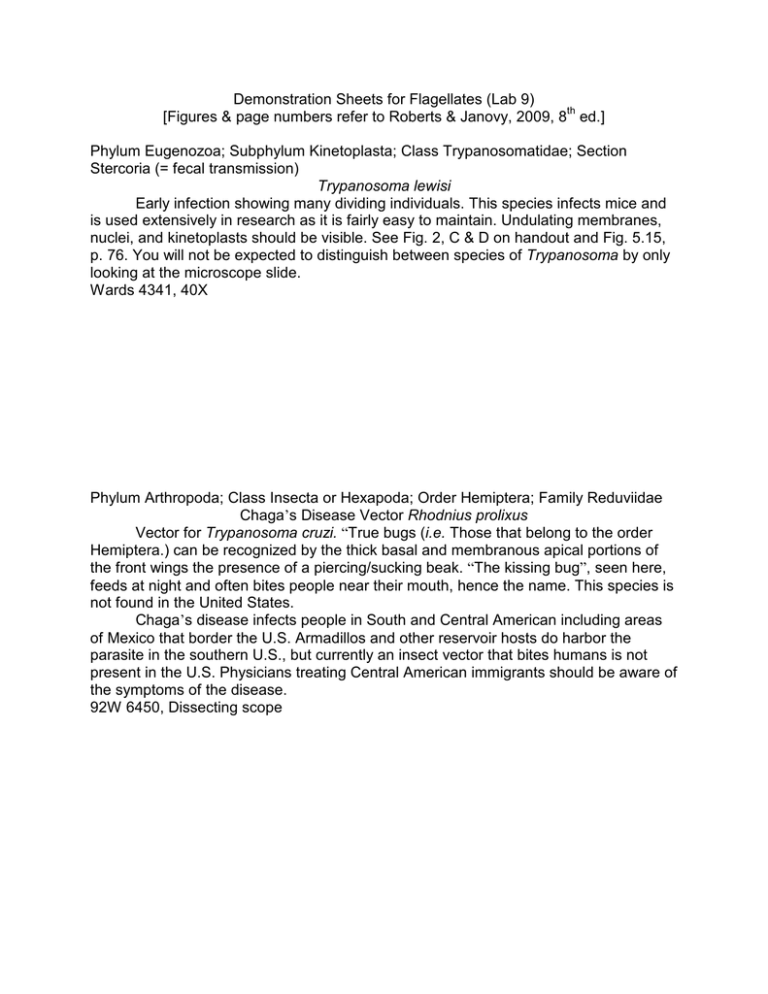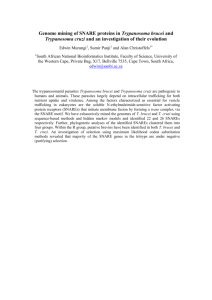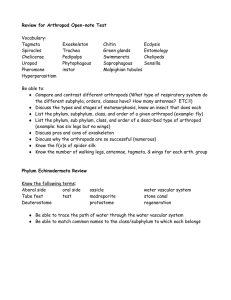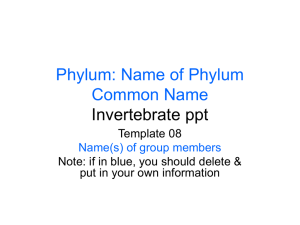Demonstration Sheets for Flagellates (Lab 9)
advertisement

Demonstration Sheets for Flagellates (Lab 9) th [Figures & page numbers refer to Roberts & Janovy, 2009, 8 ed.] Phylum Eugenozoa; Subphylum Kinetoplasta; Class Trypanosomatidae; Section Stercoria (= fecal transmission) Trypanosoma lewisi Early infection showing many dividing individuals. This species infects mice and is used extensively in research as it is fairly easy to maintain. Undulating membranes, nuclei, and kinetoplasts should be visible. See Fig. 2, C & D on handout and Fig. 5.15, p. 76. You will not be expected to distinguish between species of Trypanosoma by only looking at the microscope slide. Wards 4341, 40X Phylum Arthropoda; Class Insecta or Hexapoda; Order Hemiptera; Family Reduviidae Chaga’s Disease Vector Rhodnius prolixus Vector for Trypanosoma cruzi. “True bugs (i.e. Those that belong to the order Hemiptera.) can be recognized by the thick basal and membranous apical portions of the front wings the presence of a piercing/sucking beak. “The kissing bug”, seen here, feeds at night and often bites people near their mouth, hence the name. This species is not found in the United States. Chaga’s disease infects people in South and Central American including areas of Mexico that border the U.S. Armadillos and other reservoir hosts do harbor the parasite in the southern U.S., but currently an insect vector that bites humans is not present in the U.S. Physicians treating Central American immigrants should be aware of the symptoms of the disease. 92W 6450, Dissecting scope Phylum Eugenozoa; Subphylum Kinetoplasta; Class Trypanosomatidae; Section Stercoria (= fecal transmission) Trypanosoma cruzi Trypomastigote stage Agent causing Chaga’s Disease. Found in the blood of humans and other mammals. (Fig. 5.8; p. 71). 92W 4300, oil Uninfected Heart Tissue This slide is to be used for comparative purposes and to help you identify Trypanosoma cruzi in the adjacent demonstration. Be able to distinguish between a blood vessel containing healthy red blood cells and a pseudocyst of T. cruzi that contains amastigotes. The pseudocyst will be inside a muscle fiber while the blood vessel in surrounded by endothelium and muscle fibers H1790, 40X Phylum Eugenozoa; Subphylum Kinetoplasta; Class Trypanosomatidae; Section Stercoria (= fecal transmission) Trypanosoma cruzi Amastigote stage In cardiac muscle. See Fig. 4, Y on handout and Fig. 5.10 (p. 73) in your text. Wards 4303, 40X Phylum Arthropoda; Class Insecta or Hexapoda; Order Diptera; Family Muscidae Glossina Sleeping Sickness Vector This is the infamous tsetse fly, the vector for the organisms causing African sleeping sickness: Trypanosoma brucei brucei, T.b. rhodesiense, & T.b. gambiense. See Fig. 5.5, p. 65. The T. brucei complex are blood parasites of African ruminants such as zebras and antelope and are not pathological to mammals native to Africa. They do produce fatal infections in European livestock. The tsetse fly and T. brucei have until recently prevented humans from converting the tropical jungles of Africa to ranchland. (See Fig. 5.6, p. 66.) Consequently, many areas of central Africa have ecosystems with large predators such as lions, leopards and hyenas because of the fly and its symbionts. Turtox P9.6891, Dissecting scope Uninfected Human Blood This slide is to be used for comparison with the adjacent example. The blood is stained with Wright’s stain. Cells with purple nuclei are healthy white blood cells and are NOT manifestations of a parasitic disease. CBS 46455, 40X Phylum Eugenozoa; Subphylum Kinetoplasta; Class Trypanosomatidae; Section Salivaria (= hypodermal transmission) African Sleeping Sickness Trypanosoma brucei gambiense Trypomastigote form CBS PS310, 40X Uninfected Human Skin This slide is to be used to help you identify Leishmania tropica seen in the adjacent demonstration. Ward’s 93W 7001, 10X - 40X Phylum Euglenozoa; Subphylum Kinetoplasta; Class Trypanosomatidae Leishmania tropica Oriental Sore or Baghdad Blot This slide shows the parasites in vertebrate skin tissue. Only the amastigote form is found in humans and other vertebrates. This is a zoonotic disease commonly carried by dogs. The vector is a biting sand fly within which the promastigote form is found. Tropical Biological (mounted reversely), Leishmania tropica #3, 10X - 40X Phylum Retortamonada; Class Diplomonadea Giardia intestinalis Trophozoite stage Mobile physicians commonly have to treat people for this intestinal parasite following a camping vacation or a trip outside of the United States. Without special lighting the flagella are not easily seen on our slides, therefore the examples you see in lab will only vaguely resemble the figures in your text (Figs. 6.4. 6.5 & 6.6 (pp. 91-92). The trophozoite is easily distinguished from other intestinal protozoans by the presence of adhesive discs (seen most clearly in ventral view). From this angle, the two nuclei with their nucleoli give the organisms the appearance of a face. PS 210, oil Phylum Parabasalia, Class Trichomonada Trichomonas vaginalis It is transmitted by sexual activity and is found in the reproductive tracts of men and women. Sometimes the only symptoms may be a white discharge with may be overlooked by the infected individual. 92W 4273, oil Termite Flagellates Termites cannot digest cellulose by themselves, but are assisted by many species of mutualistic flagellates that live in the intestinal tract and convert the substrate into sugars that are used by the hosts. Some of the flagellates harbor mutualistic bacteria that assist in the break down the cellulose. Not all the flagellates consume cellulose; some are predators. Thus, the gut of a termite contains its own ecosystem. PS 340, 10X




